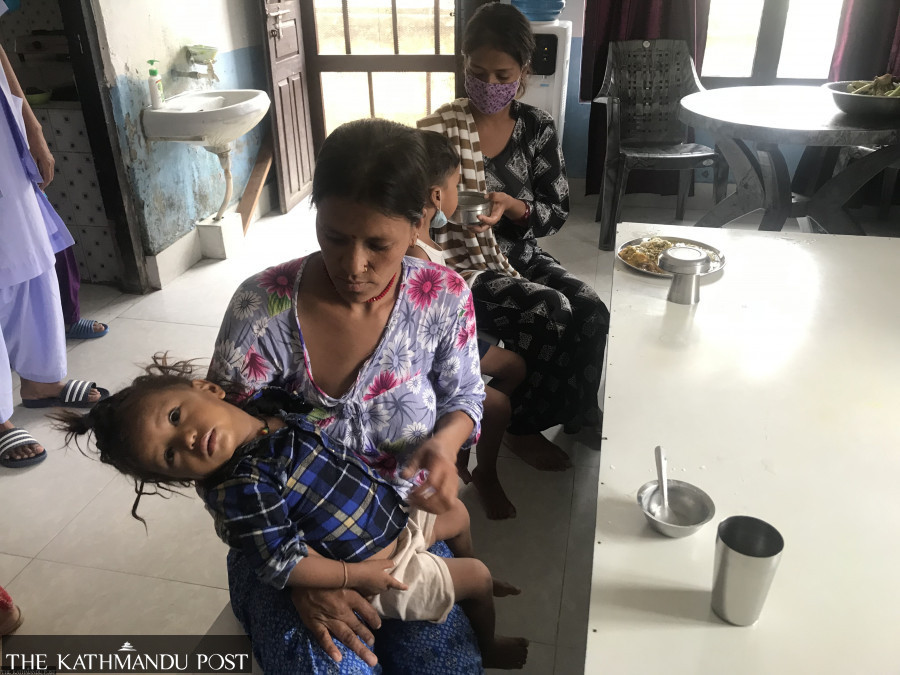Health
Budget cut set to hit crucial nutrition programmes
Nutritionists warn the country cannot achieve nutrition targets by cutting investments on Outpatient Therapeutic Care and nutrition rehab centres.
Arjun Poudel
The Nutrition Section of the Family Welfare Division under the Department of Health Services had planned to expand Outpatient Therapeutic Care (OTC) to all health posts throughout the country in the fiscal year 2080/81.
Of over 3,800 health posts operating throughout the country, only around 1,000 health
posts have been providing OTC services that involve management of non-complicated cases of severe acute malnutrition in outpatient care using ready-to-use therapeutic foods.
“But due to cuts in the national budget for health, the programme cannot be extended this year,” said Lila Bikram Thapa, chief of the section. “The programme was crucial to lessen the existing burden of malnutrition in Nepal.”
Malnutrition is considered a silent health crisis in Nepal. The country has made significant progress in reducing stunting among children under five. Stunting decreased from 57 percent in 2001 to 25 percent in 2022, according to a preliminary report of the Nepal Demographic and Health Survey-2022.
Wasting, a debilitating disease that causes muscle and fat tissues to waste away, among children under five, decreased from 11 percent in 2001 to eight percent in 2022.
Wasting or low weight for one’s height in children, if not treated properly and on time, is associated with a higher mortality risk, according to the World Health Organisation.
Experts say malnutrition affects children’s mental growth, too, which in turn undermines the country’s economic health. It weakens intellectual capacity, limits productivity in adulthood, and increases vulnerability to certain diseases.
Along with a halt in the extension of the OTC services, several other programmes of nutrition—expansion of nutrition rehab centres, and purchase of equipment to measure height and weight of the children—have also been affected due to budget cuts, officials said.
The government has allocated Rs83.99 billion to the health sector for the upcoming fiscal year 2023-2024, a major cut from the nearly Rs104 billion allocated for the current fiscal year. Officials said the total budgetary allocation for health, also includes the health budgets of local and provincial governments.
Thapa said that around 35 percent of the health budget for the upcoming fiscal year has been slashed and agencies under the Ministry of Health and Population have been adjusting the programmes.
“No new programme of nutrition will be commenced in the upcoming fiscal year due to budget cuts,” said Thapa.
Even though a preliminary report of the Nepal Demographic and Health Survey-2022, showed some improvement in the country’s overall nutrition status, the progress is not the same in all provinces.
More than 16 percent of children under five years of age in Lumbini Province have been found to be suffering from wasting, the most immediate, visible, and life-threatening form of malnutrition.
Likewise, around 10 percent of children under the age of five years in Madhesh Province have been found suffering from wasting.
Nutrition experts say the government’s plan to achieve the United Nations-backed Sustainable Development Goals (SDGs) targets, cannot be met by slashing the budget of crucial nutrition programmes.
“Slashing the budget meant for extension of OTC services, nutrition rehab centres and growth monitoring means the government is not serious towards the nutrition issues,” said Dr Atul Upadhyay, a nutritionist. “All the said programmes are crucial ones and cutting the budget of those programmes means we are not going to achieve SDG2 (ending all forms of malnutrition).”
Nepal also has an international obligation to improve the condition of malnourished children.
The country needs to reduce stunting to 15 percent from the existing 32 percent by 2030 in order to meet SDGs targets, wasting to 4 percent from the current eight percent, underweight to 10 percent from the existing 19, and anaemia to 10 percent from over 43 percent at present.
SDGs, a follow-up on the Millennium Development Goals (MDGs), aim to end poverty and hunger and all forms of inequality in the world by 2030, and Nepal has committed to meeting the goals.
“We cannot stop medicines for blood pressure and blood sugar once started even if both problems are in control,” said Upadhyay. “Similarly, we cannot achieve our targets by slashing investments in nutrition programmes.”




 12.12°C Kathmandu
12.12°C Kathmandu














